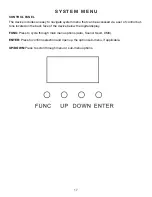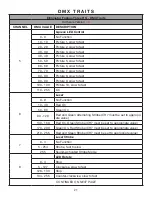
8
L A S E R W A R N I N G S A N D S A F E T Y
After completing setup, and before public use, test the laser to ensure proper function. Do not use
if any defects are detected. Do not use if the laser emits only a few laser beams rather than dozens/
hundreds, as this could indicate damage to the diffraction grating optic, and could allow emission of
laser intensity levels that exceed Class 3R.
• Do not point lasers at people or animals. Never look into the laser aperture or directly at laser
beams.
• Do not point lasers into areas which could create instances of unintentional or harmful exposure,
such as uncontrolled balconies, etc.
• Do not point lasers at highly reflective surfaces, such as windows, mirrors, and shiny metal. Even
laser reflections can be hazardous.
• Never point a laser at aircraft. This is a federal offense.
• Never point un-terminated laser beams into the sky.
• Do not expose the output optic (aperture) to cleaning chemicals.
• Do not use laser if the laser appears to be emitting only a few beams.
• Do not use the laser if the housing is damaged, the housing is open, or if the optics appear dam-
aged in any way.
• Never open the laser housing. The high laser power levels inside of the protective housing can
start fires, burn skin, and will cause instantaneous eye injury.
• Never leave this device running unattended.
• The operation of a class 3R laser show is only allowed if the show is controlled by a skilled and
well-trained operator who is familiar with the information enclosed in this manual.
• The legal requirements for using laser entertainment products vary from country to country. The
user is responsible for determining the legal requirements at the location/country of use.
• Always use proper lighting safety cables when hanging lights and effects overhead.









































